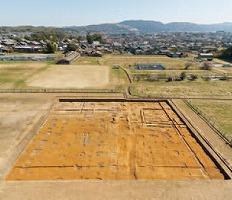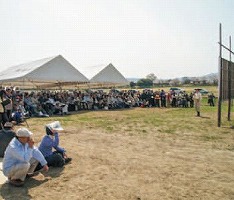
NABUNKEN NEWS vol.49
Investigation of the East Palace Sector, Nara Palace Site (Heijo No. 503)
The Nara palace has an extended square zone in the east, measuring about 250 meters east-west and about 750 meters north-south. The ambit of the southern half of the square (about 350 meters north-south) is referred to as "the East Palace Sector". Based on historical documents including "the Shoku-nihongi" (lit. continuation of the Nihon-shoki, Chronicles of Japan), this sector is known as the space at which the East Palace, the crown prince's palace, or the emperor's palace was placed.
Since 2006, the Nara National Research Institute for Cultural Properties has continued excavations focusing on the western side of the East Palace Sector. Meanwhile, this investigation aimed to elucidate aspects of the structural remains in the zone from the western side to the pivotal location. The investigation started on December17, 2012 and ended on May 22, 2013.The investigation area measured 1,015 sq. meters.
Through this investigation, we identified a number of structural remains (eg, dug-standing pillar building, dug-standing pillar walls, ditches, earth pits, platform-like structural remains, etc.) extending across multiple time periods during the Nara Period. Based on past investigation results including those acquired at the periphery, these structural remains can be divided into six time periods from the first to the sixth period.
As the highlight of these results, it is noteworthy that we were able to identify a cloister dating back to the end of the Nara Period, discovered in a past investigation. We clarified that there is a north-south ridge building, long, massive, and extending from the south side, and that the building direction turns toward the east at its midpoint, and extends further east. It was apparent that this building was a cloister compartmentalizing the pivotal zone of the East Palace. In other words, at the end of the Nara Period, the pivotal zone of the East Palace was compartmentalized by the cloister. In addition, it became clear that this investigation section corresponds to the northwest corner of the pivotal zone.
According to the Shoku-nihongi, in the East Palace sector, was Emperor Kōnin's palace, referred to as "Yōbai-kyu Palace", completed in 733, the end of the Nara Period. At this palace, various ritual ceremonies and banquets were held by the emperor and aristocrats. The cloister identified through this investigation may have been the facilities which compartmentalize this "Yōbai-kyu Palace", and it will be necessary in future to clarify the actual aspects of the "Yōbai-kyu Palace" including the inner facilities surrounded by this cloister, surrounding buildings, etc.
The cloister identified by this investigation is a large-scale building of the "single corridor" type (pillars form two rows) with dug-standing pillars, measuring about 6 meters in the span direction.
Through past investigations, a building of a similar-scale to the cloister was confirmed to have been built in this East Palace Sector in the middle of the Nara Period. In addition, it has been confirmed that in the latter half of the Nara Period too, another cloister of the same single corridor type with dug-standing pillars was built, although their sizes are different,.
Based on these results, it has became clear that in the pivotal zone of the East Palace Sector, the facilities compartmentalized by a cloister of the single corridor type were built/rebuilt continuously in and after the Middle Nara Period. Despite changes in scale and location due to multiple incidences of rebuilding, the space surrounded by the cloister in the pivotal zone of the East Palace Sector was used continuously, indicating a part of the characteristics of this zone at which royal ritual ceremonies and banquets were held.
Furthermore, these investigations are gradually making clear the difference of land-use between the western side part where large buildings with dug-standing pillars and buildings with internal columns stood side by side and the pivotal zone surrounded by the cloister. These results are important clues to figure out the changes in the structural remains and aspects of space-use of the entire East Palace Sector.
Incidentally, we held a field briefing on March 30, to which 820 visitors came in fine weather best suited to viewing full-blown cherry-blossoms. I realized the high interest of citizens in the excavation of the Nara palace Site. As the investigation of the East Palace Sector continues, please look forward to future progress!
(ODA Yūki, Department of Imperial Palace Sites Investigations)
 Full view of the investigation sector(Seen from the west) |
 Field briefing ongoing (Seen from the northeast) |
